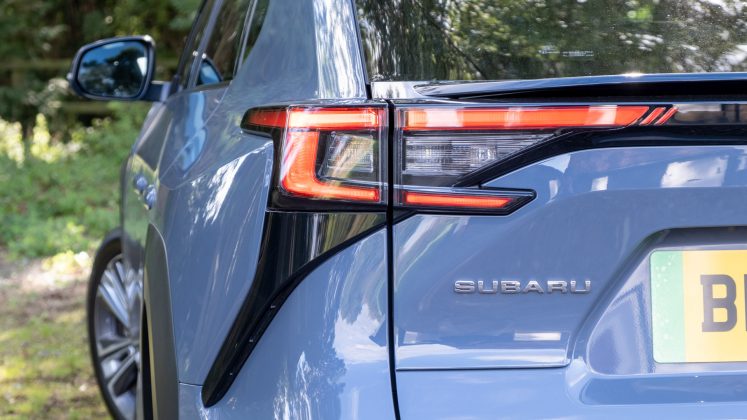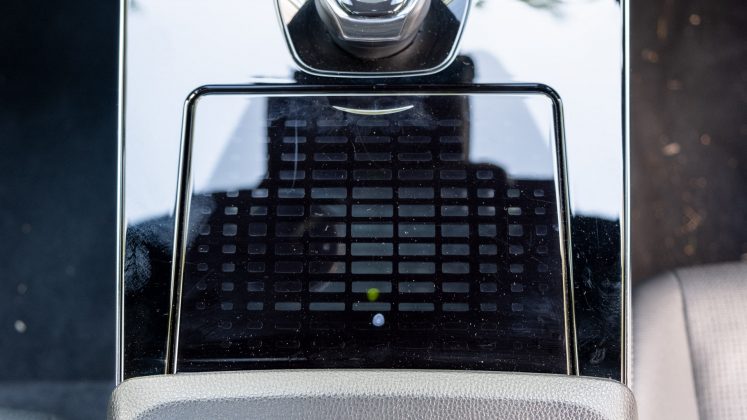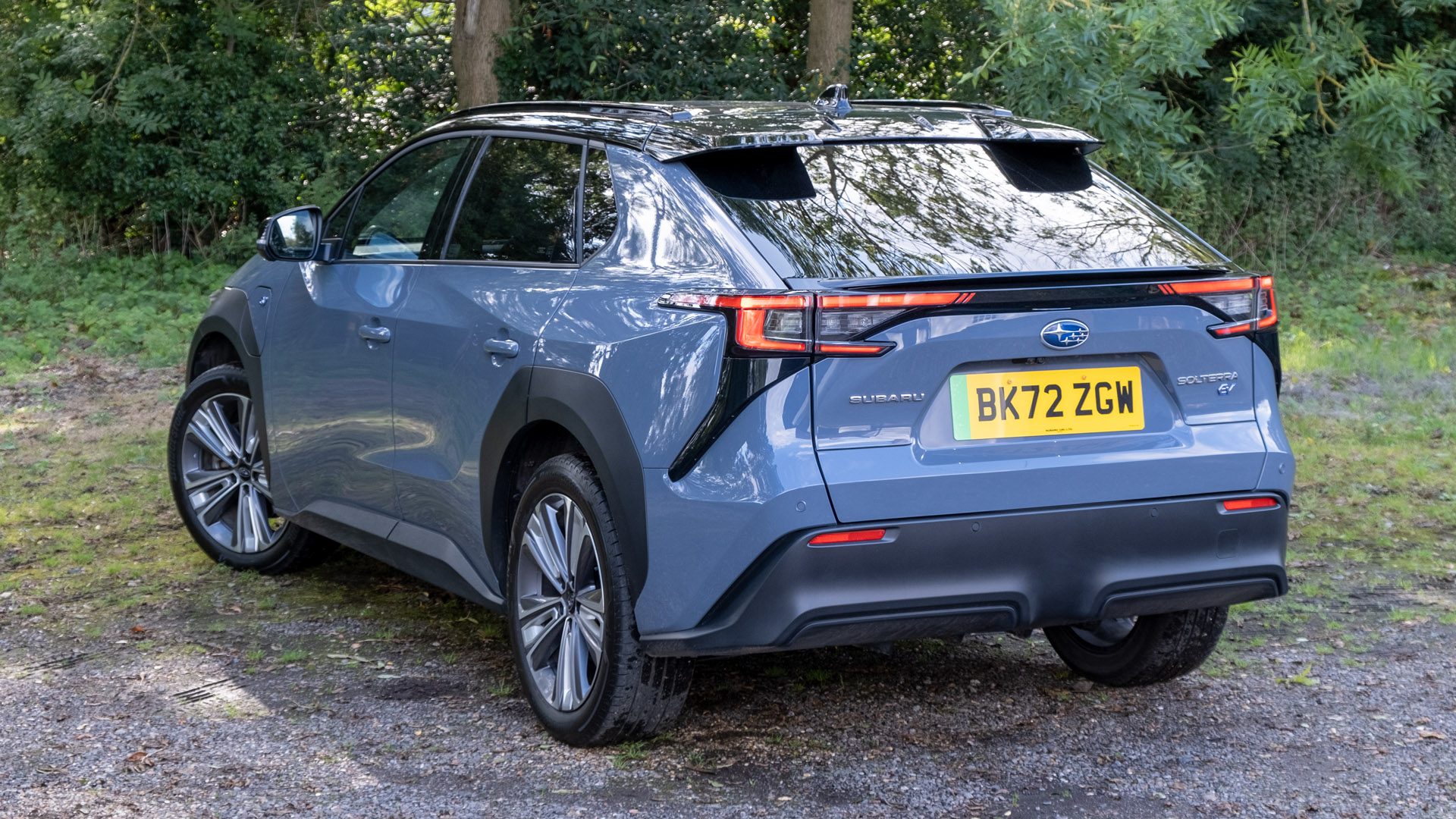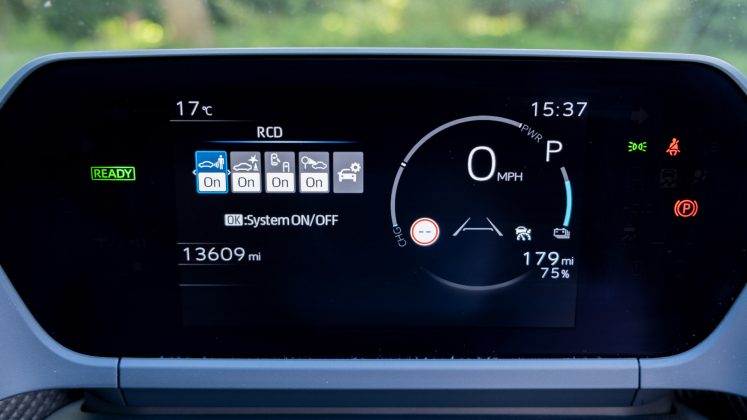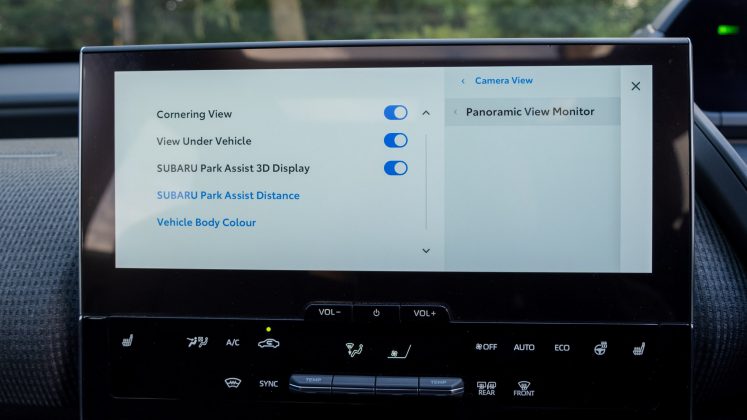The Subaru Solterra is the manufacturer’s first fully electric vehicle. The SUV is a carbon copy of the Toyota bZ4X, as the Japanese automakers share the same EV platform. However, at the time of writing, the Subaru is solely available as an all-wheel drive (AWD) vehicle, while the Toyota comes with both an AWD and front-wheel drive (FWD) setup. The FWD model was a later addition to the manufacturer’s line-up.
If you’d prefer to watch a review of the Subaru Solterra, head on over to our YouTube channel.
Subaru Solterra price & competition
As such, we wouldn’t be surprised to see Subaru offering its customers a cheaper alternative in the near future; as the bZ4X starts from £46,110, as opposed to the Solterra that comes in at £52,495 for the Limited trim, and £55,495 for the Touring spec.
A breakdown of the trims can be found below (click to expand):
Find the best Subaru Solterra deals
Looking at the all-electric SUV market, there are numerous vehicles to consider – focusing on AWD models, here are a few to consider: the Skoda Enyaq iV 80x from £51,275; the Volkswagen ID.4 GTX from £51,580; the Kia EV6 GT-Line AWD from £51,595; the Hyundai Ioniq 5 AWD Ultimate from £51,900; the Tesla Model Y Long Range from £52,990; the Mercedes EQA 350 4MATIC from £53,010; the BMW iX1 xDrive30 from £53,295; the Audi Q4 50 e-tron from £55,310; the Volvo XC40 Recharge Twin from £56,150; the Genesis GV60 Sport from £58,365; the BMW iX3 from £62,865; the Jaguar I-Pace from £66,350; the Audi Q8 e-tron from £67,800; the Mercedes EQC 400 4MATIC from £70,035; the Ford Mustang Mach-E GT from £72,830; the Tesla Model X from £95,390; and the BMW iX xDrive50 M Sport from £107,305.
Read next: Kia Niro EV review: An upgraded e-Niro?
Subaru Solterra exterior review
In comparison to the vast majority of its competitors, the Solterra is positioned as an off-roader and therefore has oversized plastic wheel arches. Unfortunately, these detract from its exterior look, with the Subaru being arguably one of the ugliest in its price category.
That’s quite a shame, as it’s otherwise quite attractive. The frontal profile is accentuated and somewhat aggressive, the 18” in the Limited trim or pictured 20” alloys in the Touring give it a sportier stance, while its rear has a slight flare to it.
In terms of your colour options, ‘Platinum White Pearl Mica’ comes as standard on both trims. In the ‘Limited’ trim, ‘Precious Metal’, ‘Midnight Black’, ‘Dark Blue Mica’ and ‘Harbour Mist Grey Pearl’ cost an additional £650. In the ‘Touring’ model, the same colours are available but with the addition of ‘Emotional Red’ at £650, and the pictured ‘Harbour Mist Grey Pearl/Black Roof’ at £1,045.
As for its roof load capacity, it’s rated at 75kg. Its towing capacity sits at 750kg for both baked and unbraked trailers, which is pretty poor when compared to most of its rivals and considering its off-roading traits.
Read next: Audi Q8 e-tron review: An upgraded electric SUV
Subaru Solterra interior review
Its interior design is not much better, with hard scratchy plastic used throughout the cabin and an unrefined area found underneath the centre armrest compartment. Given its price tag, one might have expected far superior build quality and materials but alas that’s not the case.
With that said, it has a practical design with physical buttons found on the steering wheel and a flurry of them found by the centre console. You even have dedicated climate control buttons, which are very much appreciated as most manufacturers are now omitting them altogether.
The Solterra also has a modern touch with its responsive 12.3” infotainment system. It’s not overly complicated to use and with most of the vehicle settings on the driver’s display, the centre screen is easy to navigate. It also supports Android Auto and Apple CarPlay over a wired connection, with the latter also working over a wireless connection. At the time of writing, Android Auto is not supported wirelessly, but this could come in later via a firmware update.
Read next: Kia EV6 review: The Hyundai Ioniq 5 alternative
At the moment, however, you will find that turn-based navigation data from the third-party mobile operating systems and the built-in sat-nav feed through information to the 7” instrument cluster. The driver’s display itself is vivid and somewhat customisable. It’s also quite different from other vehicles we’ve reviewed, in that it’s set back from the steering wheel. This also means the steering column is elongated, with the 7” display sitting closer to the windscreen. Truthfully, it makes no difference and in some ways is an in-between of a Head-Up Display (HUD) and a normal instrument cluster, which we quite like. Given its design, it’s no surprise to see the HUD omitted altogether.
In terms of its audio system, six speakers are housed within the ‘Limited’ trim, while the ‘Touring’ model has a punchy nine-speaker Harman Kardon system. The latter is a worthwhile upgrade as it adds a subwoofer and tweeters at the rear of the cabin. You can hear how it performs by watching our dedicated audio review on YouTube.
Subaru Solterra storage review
Should you want to attain the utmost audio fidelity, you’ll want to plug in your smartphone to the infotainment system. The USB Type-A port is found underneath a flap by the centre console. Unfortunately, it’s not been thought out, as the area won’t accommodate a large-sized smartphone while plugged in; your phone will be diagonally wedged instead. Of course, if you don’t connect over a wire to the infotainment system, you can place your smartphone in this bay, which doubles up as a wireless smartphone charger in the ‘Touring’ trim.
Aside from the top-mounted USB Type-A port, there are also two USB Type-C ports and a 12V socket for charging located underneath the centre console. The large open area has a fabric material that prevents loose change or keys from rattling around; that is if you don’t take the vehicle’s manual and documents everywhere you go, as there is no glove box. Equally, it’s rather odd to see the storage compartment underneath the centre armrest not lined in any fabric; the plastic area resides beneath the removable tray.
Nonetheless, storage within the cabin is pretty good, with all the door bins large enough to accommodate one to two 500ml bottles alongside small-to-medium-sized valuables. The use of harsh plastic is present again, and given they’re not lined in any fabric, which means your reusable water bottle or valuables will be heard rattling around.
At the rear, there’s a pulldown armrest compartment, which reveals two cupholders and a cut-out for a smartphone. Speaking of which, there are two USB Type-C ports for charging at the back of the centre console.
Of course, for even more storage there’s the boot. With the seats in place, you’ve got 441-452 litres, while there’s ample space with them folded flat. The manufacturer hasn’t shared a figure, but we’d guestimate at around 1,400-1,600 litres.
Here’s how its boot stacks up to its rivals: Tesla Model Y (854/2,100 litres); Audi Q8 e-tron (569/1,637 litres); Skoda Enyaq iV (585/1,710 litres); Genesis Electrified GV70 (503/1,678 litres); VW ID.5 (549/1,561 litres); VW ID.4 (543/1,575 litres); Hyundai Ioniq 5 (520/1,587 litres); BMW iX3 (520/1,560 litres); Jaguar I-Pace (656/1,453 litres); Audi Q4 e-tron (520/1,490 litres); Genesis GV60 (432/1,550 litres); BMW iX1 (490/1,495 litres); Citroen e-C4 X (510/1,360 litres); Kia EV6 (490/1,300 litres); Volvo XC40 Recharge Twin (452/1,328 litres); Ford Mustang Mach-E (402/1,420 litres); Mercedes EQA (340/1,320 litres); Citroen e-C4 (380/1,250 litres); and Smart #1 (411-976 litres).
When it comes to convenience, there’s an electric tailgate that comes fitted as standard, 60:40 rear-split folding seats, a 12V socket, fixing points, a flat loading bay and a large underfloor compartment that can accommodate the vehicle’s charging cables and even the retractable and removable boot load cover. Clever thinking by the manufacturer. However, there is no ski latch or any extra storage at the front of the vehicle (often referred to as a frunk).
Read next: Skoda Enyaq iV review: The Volkswagen ID.4 alternative
Subaru Solterra comfort review
Aside from its practical boot design, the vehicle’s cabin is also pretty spacious. Headroom and legroom will be a non-issue for 6-foot 2-inches (188cm) individuals, with the seats themselves being accommodating and soft. However, due to the positioning of the battery pack, the rear seats are diagonally wedged, which can cause a bit of discomfort on longer drives. Equally, headroom for taller individuals is limited for those sitting in the rear middle seat.
Speaking of which, it’s great to see that the rear footwell design has been optimised with a near-flat floor. There are even reclining rear seats, which are also heated for added comfort. At the front, the front two and the steering wheel are also heated. In terms of adjustments, the driver’s seat is electric as standard, while the passenger seat is manually operated. Should you want electric controls for the passenger, a driver’s memory function, and a fixed panoramic glass roof with an electronically adjustable sunshade, you’ll have to opt for the ‘Touring’ model.
Another aspect that affects comfort is cabin noise, which has been kept down to a minimum in the Solterra. Both tyre noise and wind noise have been suppressed, providing for a pretty serene in-cabin experience.
Read next: Citroen e-C4 review: Most comfortable SUV?
Subaru Solterra performance review
Equally, its suspension system has been tuned to perfection. It soaks up the anomalies, speed bumps and potholes with ease and yet provides great stability on more challenging routes; for a vehicle of its class, body roll is kept down to a minimum. Granted, its suspension system isn’t as advanced as the Citroen e-C4, e-C4 X or Audi Q8 e-tron, but it’s still among one of the most comfortable all-electric SUVs to drive.
One could also sing praise about its brakes, which feel progressive and controlled. Unlike a lot of its competitors, the Subaru feels suitably equipped to come to a standstill in an emergency situation. Its all-wheel drive (AWD) system is also faultless, with traction in even trickier terrains being a breeze. In fact, we’d go as far as saying that it’s the best all-electric SUVs for off-roading. Thanks to its all-terrain X-Modes, the vehicle copes with anything and everything you throw at it; one has the utmost confidence in deep snow or mud, especially with a ground clearance of 211mm.
There’s also a surprising amount of connection one has with the front axle. The Solterra is both responsive and stable. It’s plenty of fun to drive with its low centre of gravity planting the car to the ground. With that said, it can’t quite compete with the likes of the BMW iX1 and Jaguar I-Pace in their ability to provide a heightened driver’s feel.
Find the best Subaru Solterra deals
This brings us to performance, with its two 80 kW electric motors combining with the 71.4 kWh battery pack to output 160 kW of power (215 hp) and 336 Nm of torque. Using Racelogic’s Performance Box Touch, we clocked in a time of 0-20mph in 1.65 seconds, 0-30mph in 2.48 seconds, 0-60mph in 6.37 seconds, 50-70mph in 3.43 seconds and a peak of 0.56g of acceleration. Top speed is limited to 100mph. These aren’t exactly electrifying results, namely for an all-wheel drive vehicle but should suffice for the large majority of consumers.
Where the Solterra does fall short, however, is in its ability to deliver a competent electric driving range with its 71,4 kWh battery pack and included heat pump falling short of expectations. The manufacturer claims one can attain 289 miles in the ‘Limited’ spec and 257 miles in the ‘Touring’ model. In reality, we netted 180-200 miles in our mixed driving tests.
To put things into perspective, here’s how it stacks up to its rivals: the VW ID.5 clocked in an impressive 325 miles; the Skoda Enyaq iV 80 300 miles; the Tesla Model Y Long Range 260-280 miles; the Audi Q8 e-tron 55 and Smart #1 Premium 250-270 miles; the Audi Q4 e-tron and the heat pump-less Volkswagen ID.4 attain around 260 miles; the Kia EV6 RWD 240-260 miles; the Jaguar I-Pace and Volvo XC40 Recharge Twin both sit around 240-250 miles; the Hyundai Ioniq 5 AWD Ultimate 230-250 miles; the BMW iX1 225-245 miles; the BMW iX3 nets 235 miles; the Genesis GV60 Sport+ 210-230 miles; the Mercedes EQA 250 210-220 miles; the Genesis Electrified GV70 200-220 miles; the BMW iX xDrive40 M Sport 200-210 miles; the Audi e-tron S 190-210 miles; the Ford Mustang Mach-E 180-200 miles; the Citroen e-C4 and Citroen e-C4 X 180-200 miles.
Indeed, the Solterra provides one of the shortest electric driving ranges in its price category and is even trumped by some cheaper alternatives. It’s especially disappointing considering some Subaru owners will be looking to take this off-grid; as such, its USP of being an off-roader is almost irrelevant as you won’t be able to do cross-country tours.
Another area of concern is its way of dealing with regenerative braking. When lifting off the accelerator pedal, it takes a few seconds before the vehicle starts to decelerate; an odd sensation and one that we’ve never felt before in an EV, as it’s usually instant. This means it can be hard to rely on the one-pedal mode, which aims to provide a less cumbersome driving experience when you’re in and around town. It’s also worth highlighting that you can’t come to a complete standstill in said mode. Nonetheless, you have a few regenerative braking levels to choose from via the flappy paddles found behind the steering wheel.
Of course, one can recoup energy at a much more rapid rate by plugging it in. According to the manufacturer, you can attain up to 150 kW of charge through its CCS port, meaning a 20-80% charge will take just 30 minutes. However, there have been a few cases of owners not hitting anywhere near the targeted level, with the vehicle’s charging curve also being quite poor. TotallyEV can’t comment on these stories, as we didn’t use a DC charger in our time of testing.
Aside from this, using a 50 kW charger will take you one hour to attain the same level of charge, while plugged into a 7 kW AC charger will take 7-8 hours, with a 3-pin wall plug taking over 35 hours. It’s a shame that the onboard charger is limited to 7 kW, with no option to upgrade to a faster 11 kW or 22 kW onboard charger; handy for those who regularly charge at an AC charge point.
Read next: BMW iX1 review: The best driver’s feel
Subaru Solterra safety review
Subaru is renowned for its safe vehicles, and it should therefore come as no surprise to learn that the Solterra achieved the full 5/5 stars on Euro NCAP’s crash tests; scoring 88% in Adult Occupancy, 87% in Child occupancy and 91% in its Safety Assist scores.
In terms of the driver assistance systems, you have a plethora of them fitted as standard: Dynamic Radar Cruise Control (DRCC), Pre-Collision System (PCS), Emergency Steering Assist, Lane Departure Alert (LDA), Lane Tracing Assist (LTA), Blind Spot Monitor (BSM), Road Sign Assist (RSA), Rear Cross Traffic Alert (RCTA), Parking Support Brake (PSB), Low-Speed Acceleration Suppression, and Safe Exit Assist (SEA) System.
We found DRCC excellent in regulating the distance between you and the leading vehicle, while LTA keeps the vehicle at the centre of the lane – handy for when you’re on the motorway. However, RCTA was a bit too intrusive, with the vehicle performing intrusive emergency stops on multiple occasions.
Buy a car phone mount on Amazon (Affiliate)
When it comes to parking, the vehicle has an 11.2-metre turning circle, which makes manoeuvrability a breeze. Parking sensors and 360-degree cameras come fitted as standard too. In terms of visibility, it’s excellent at the front and side, however, the rear window omits a wiper, which is quite baffling due to its off-roading capabilities.
Read next: Jaguar I-Pace review: Better than newer rivals?
TotallyEV’s verdict on the Subaru Solterra
The Subaru Solterra is a comfortable, practical, safe, feature-packed and capable all-electric off-roader. However, its lacklustre performance, electric range and choice of materials within the cabin let it down, meaning we can’t see ourselves actively recommending it over rival alternatives.
Find the best Subaru Solterra deals
What do you make of Subaru’s first EV? Let us know in the comments section below or via social media; we’re on: YouTube, Instagram, Facebook, X and LinkedIn.











